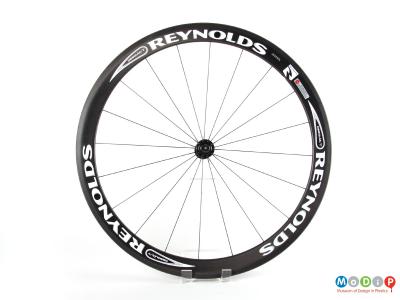A wheel needs to have strength to withstand stresses and strains put on it from the weight of its load, and from the road surface it is moving along. In the past bicycle wheels, like frames, were constructed out of a wide variety of materials. Very early cycle wheels had their origins in carriage wheels and were made of wood with iron tyres. The evolution of the wheel has led to many technological developments, including pneumatic tyres and metal construction.
Today many bicycle wheels are made of metals including steel, aluminium and titanium all of which have their benefits and downfalls. This wheel (1) is made of carbon fibre, a plastics based composite material which allows the wheels to be extremely low in weight and yet be stiff, strong and responsive to ensure that little of the forward motion transferred to them from the pedals is wasted.
The shape of the wheel also contributes to the speed and aerodynamic performance that a rider can achieve. The deep section rims help to reduce the aerodynamic drag by having a smooth and shallow taper. Along with the profile of the aero rim a designer can change the performance of a wheel by adjusting the number of spokes and their shape.
Depending on the severity of the wind and its direction the rider can use a disc wheel, either a solid carbon fibre wheel with no spokes, or a simple dished cover over the spokes. Both of these solutions reduce aerodynamic drag but are difficult to steer in a cross wind catching the air like a sail, and are therefore commonly used on the rear wheel only.

